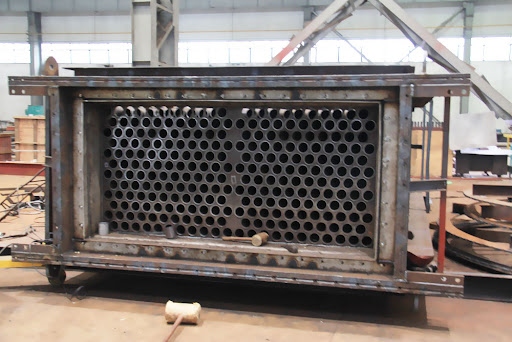Air Preheaters for Boilers are vital heat recovery components engineered to significantly enhance boiler efficiency, fuel economy, and thermal performance across industrial and commercial applications. These devices capture the residual heat from hot flue gases exiting the boiler and use it to warm up the incoming combustion air before it enters the burner. This preheating process improves combustion temperature, reduces fuel demand, and enables cleaner, more complete burning of fuels such as coal, biomass, oil, and gas.
The significance of air preheaters goes beyond basic energy recovery. In today’s energy-conscious and emission-regulated industries, they play a key role in helping facilities achieve environmental compliance, cut down on operational costs, and reduce the carbon footprint of thermal systems. Advanced rotary regenerative, tubular, and plate-type designs now incorporate smart controls, modular sections, corrosion-resistant materials, and self-cleaning mechanisms to meet the evolving demands of sectors like power generation, textile processing, pharmaceuticals, cement production, and waste-to-energy plants.
With the global transition toward sustainable thermal energy systems, Air Preheaters for Boilers are no longer optional enhancements—they have become essential heat recovery assets that support modern boiler systems in achieving peak efficiency, long life, and regulatory readiness.
Working Principle of Air Preheaters
- Flue gases exiting the boiler carry substantial heat energy.
- The air preheater transfers this heat to incoming air, raising its temperature before it enters the combustion chamber.
- Heated air enables faster ignition, hotter flame, and complete fuel combustion.
- Cooler exhaust gases exit the stack, resulting in lower heat losses.
This heat recovery not only improves boiler thermal efficiency (by up to 12%) but also lowers operating costs and emissions.
Types of Air Preheaters
Tubular Air Preheaters
- Design: Consist of parallel steel or alloy tubes where flue gas flows around the tubes, and air flows inside (or vice versa).
- Unique Enhancements:
- Spiral fins welded to tube surfaces increase turbulence and surface area.
- Suitable for marine boilers or compact industrial systems.
- Available with self-cleaning lance systems to reduce ash buildup in solid fuel boilers.
Plate-Type Air Preheaters
- Design: Thin plates arranged in a stacked format allow flue gas and air to pass through alternate channels.
- Unique Enhancements:
- Corrugated and dimpled plates increase heat exchange rates.
- Plates can be made from high-grade stainless steel or ceramic composites for corrosive environments.
- Compact, lightweight, and ideal for clean fuel combustion like natural gas.
Rotary Regenerative Air Preheaters (Ljungström type)
- Design: Rotating drum with heat-absorbing elements (matrix) that alternately contact flue gas and air.
- Unique Enhancements:
- Variable speed drives adapt rotor speed to optimize heat transfer based on load.
- Dual-sector or tri-sector designs handle different air streams (e.g., secondary air in large boilers).
- Advanced rotors with ceramic blocks resist erosion and corrosion from acidic flue gases.
Industry Applications of Air Preheaters
- Power Plants (Coal, Biomass, Gas)
– Essential for boosting boiler cycle efficiency in large-scale electricity generation. - Textile & Garment Processing
– Steam boilers in dyeing and drying processes benefit from consistent, high-temperature air. - Food Processing Units
– Steam generation for sterilization, drying, and pasteurization becomes more energy-efficient. - Pharmaceutical Manufacturing
– Sterile environments depend on precise steam generation, made more efficient with APHs. - Cement & Pulp Industries
– APHs are integrated with kiln heat recovery systems to reduce energy waste. - Chemical Processing Units
– Especially in ammonia reforming or hydrogen plants, where high-temperature combustion is critical. - District Heating Systems
– Preheated air improves the performance of low-pressure boilers supplying residential heating grids.
Modern Innovations in Air Preheater Technology
Smart Monitoring (IoT Integration)
- Sensors measure inlet/outlet temperatures, soot levels, and pressure drop.
- Data is sent to a central dashboard for predictive maintenance and performance tuning.
Self-Cleaning Mechanisms
- Compressed air pulses or rotating brushes periodically remove soot buildup, ensuring continuous efficiency.
Nanocoated Heat Transfer Surfaces
- Prevents ash, moisture, and chemical deposits on tubes or plates.
- Extends cleaning intervals and boosts heat transfer.
Modular APH Designs
- Easy to retrofit into existing boiler setups.
- Modular sections allow replacement without shutting down the entire system.
Conclusion
Air Preheaters for Boilers serve as a powerful bridge between energy efficiency and environmental responsibility. By recovering and redirecting the thermal energy from flue gases back into the combustion cycle, they drastically reduce fuel consumption, greenhouse gas emissions, and operational wear and tear on boiler systems. This not only leads to measurable economic savings but also supports long-term performance and equipment sustainability.
Today’s industrial landscape demands more than just heat generation—it demands intelligent thermal management. With innovations such as IoT-based monitoring, pulse-jet cleaning systems, variable-speed rotors, and ceramic-lined exchangers, air preheaters are evolving into smart energy-saving systems designed for real-world operating conditions.
Whether you’re managing a coal-fired power plant, designing a district heating system, or optimizing a biomass boiler, incorporating an efficient air preheater can be the defining factor in achieving consistent, eco-friendly, and cost-effective operations.

